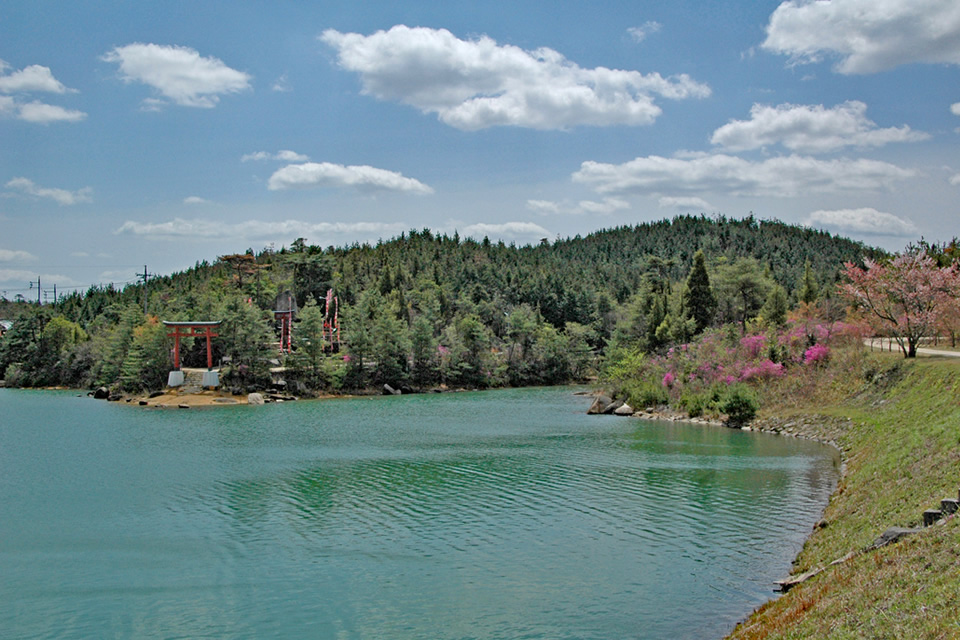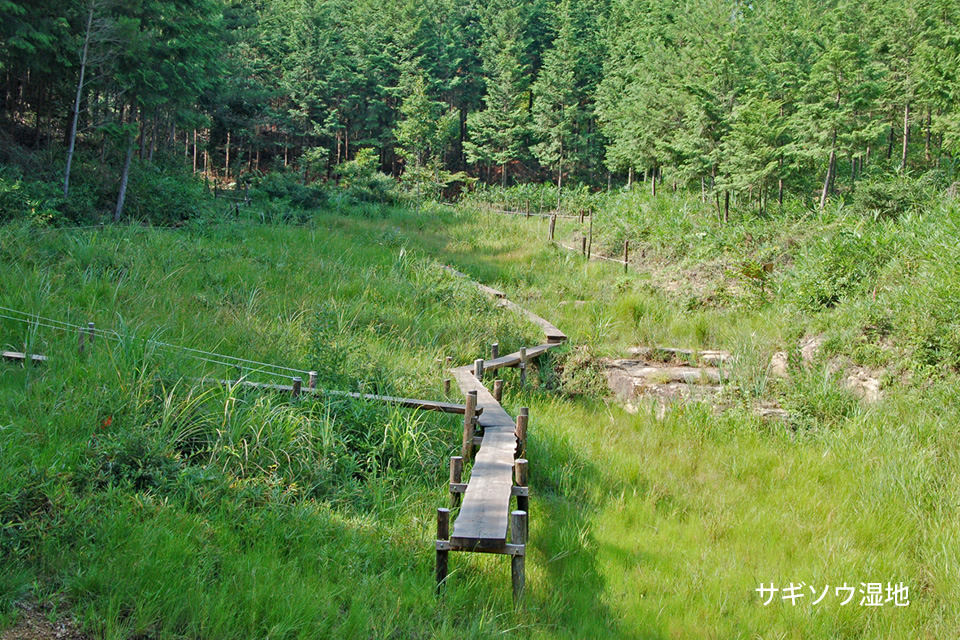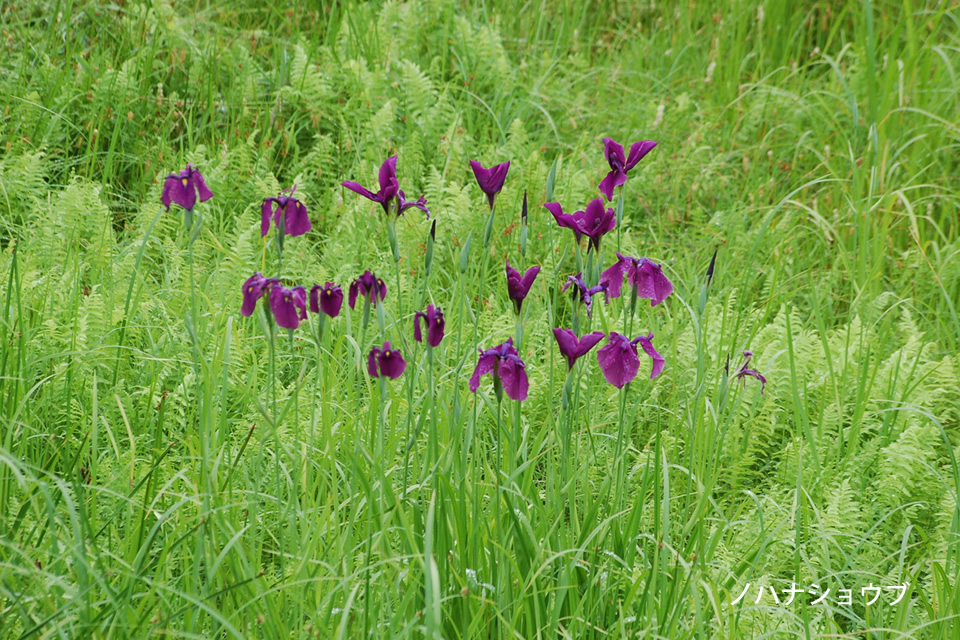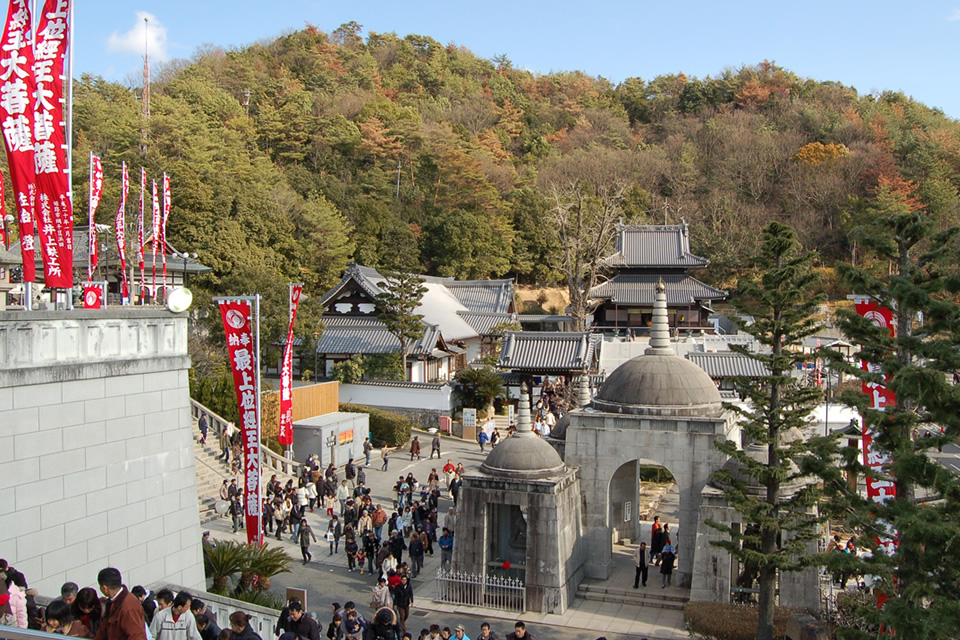Walking along the Ashimori River from Ashimori Station

Starting from Ashimori Station, walk along the car road on the embankment of the Ashimori River towards the upstream direction. After walking about 1 kilometer, the car road diverges from the river, but the walking trail follows the path on the embankment. Cross over the new bridge and continue walking along the embankment. You will reach a section where three large cherry trees are planted on the embankment. From there, you can see Nakamura Bridge.
In spring, dandelions and mustard greens while spider lilies adorn the area in autumn. By the riverside, you can observe herons and, if you're lucky, even spot a kingfisher.
From Nakamura Bridge to the torii gate of Ashimori Hachiman-gū Shrine

Cross Ashimori River at Nakamura Bridge. Continue past the side of Ashimori Medical Center and you will reach a crossroads where it intersects with National Route 429. Proceed straight ahead and after a while, you will see the stone torii gate of Ashimori Hachiman-gū Shrine on the left side.
Although it may seem like an ordinary stone torii gate, it is actually the oldest known torii gate with inscriptions in Japan. It was crafted by "Saya Myo'a" in the first year of Koan (1361) and has been designated as an Important Cultural Property by the government.
Climb up the road to reach the torii gate of Ryūsen-ji Temple

If you continue straight along the road, you will enter a steep slope that crosses a mountain pass. While passing two reservoirs on the right side, continue climbing up the slope. There is a shortcut to Ryūsen-ji Temple along the way, but keep following the road. After a while, you will see the parking lot of Ryūsen-ji Temple on the left side, along with a large signboard saying "Ryūsen-ji Entrance," and you can catch a glimpse of the stone torii gate of the temple.
There are numerous temples throughout the country that bear the name "Ryūsen-ji." In Okayama Prefecture alone, there are four temples called "Ryūsen-ji." Ryūsen-ji Temple on the Kibiji region is located in Shimo-asimori, Kita-ku, Okayama City, and its mountain name is "Saijō-Honzan." The temple grounds are spacious, with various structures scattered amidst the natural surroundings.
Ryūsen-ji Temple and Ryuō Pond


Within the grounds and surrounding area of Ryūsen-ji Temple, numerous maple trees have been planted, offering a beautiful display of autumn foliage. The trees have matured, making it a well-known spot for viewing vibrant autumn colors. Inside the temple grounds, there is a unique rock called "Yurugi-iwa" that can be moved with just one finger, weighing three thousand kan (a traditional unit of weight).
Ryuō Pond, which holds the waters of Mount Ryuō, is a large and pristine pond with a circumference of approximately 2 kilometers. It is regarded as a sacred pond of the Eight Great Dragon Kings and is carefully maintained. One famous festival held at Ryūsen-ji Temple is the "Otaki Festival," which takes place on the fourth Sunday of July.


The wetlands and nature surrounding Ryuō Pond


Around Ryuō Pond, there are scattered small-scale wetlands created by the seeping water from Ryuō Mountain. These wetlands provide habitats for wildflowers that have become less common to see and are home to dragonflies. The environment where these wetlands exist has been preserved and protected within the grounds of Ryūsen-ji Temple and the protective forest. In recent years, they have been maintained and managed by volunteers from the "Ryusenji Nature Conservation Club."


From Ryuō Pond to Okunoin Ichijō-ji Temple

To the east of the "Migawari-Jizō" located on the southern side of Ryuō Pond, there are two stone pillars. The path where the stone pillars stand leads to Okunoin Ichijō-ji Temple, located at the summit of Mount Ryuō.
Passing through the stone torii gate and walking a short distance, a flight of stone steps continues, and you emerge onto a slope lined with stone pagodas engraved with the phrase "Nam-myo Horengekyō" on both sides of the path.
Climbing the final set of stone steps, you reach Okunoin Ichijō-ji Temple.
Okunoin Ichijō-ji Temple (Located at the summit of Mount Ryuō)


At the summit of Mount Ryuō, there stands an impressive group of large stone pagodas, creating a breathtaking sight. One may wonder where and how these enormous stones were transported. While there is now a road on the northern side that allows access by car, such a path did not exist during the time of their construction. The sight of these stone pagodas alone makes the ascent to the summit worthwhile.
The view from the summit is often obstructed by the growth of trees, but there are still excellent vantage points. The lodging facilities of Okunoin Ichijō-ji Temple, known as "Syukubō," face the eastern side and are perfectly positioned for observing the "rising sun."

To Saijō-Inari Temple


From Okunoin Ichijō-ji Temple, descend the mountain and head towards Saijō-Inari Temple(Saijō-Inariyama Myōkyō-ji Temple). Along the way down, there is an eight-tatami-sized rock called "Hachijō-Iwa," where it is said that the revered monk, Ho'on Daishi, practiced. Just a short distance down the zigzagging stone steps, you will find the former main hall (rebuilt in the first year of Kan'ei period) with a hipped roof, designated as a Registered Tangible Cultural Property, standing solemnly. Saijō-Inari, known as one of Japan's three great Inari shrines alongside Fushimi Inari and Toyokawa Inari, attracts numerous worshippers from both within and outside the prefecture.
The stone-constructed Niōmon Gate, built in the architectural style of Indian halls (rebuilt in 1958), is exceptionally rare and has been designated as a Registered Tangible Cultural Property.


From Saijō-inari to Bitchu Takamatsu Station

Upon passing through the Niōmon Gate, you will traverse a shopping street lined with souvenir shops on both sides. During the New Year's period, it is lively and bustling, but on regular days, many shops remain closed, creating a shuttered street atmosphere. Walk along the straight promenade that stretches from Inari to Bitchu Takamatsu Station. As you approach the station, you will catch sight of the lush wooded Takamatsu Castle Ruins to the front-right. Make a right turn at Aoyama Dental Clinic, then a left turn at the end of the road, and you will arrive at Bitchu Takamatsu Station.
This route is suitable for those who enjoy walking and offers a scenic experience throughout the four seasons.
